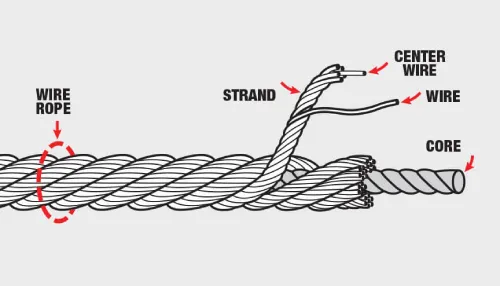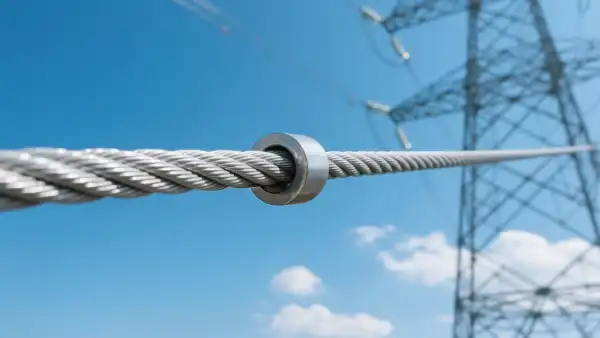If you’ve ever sent out an RFQ for “wire” and then realized the supplier quoted you something completely different from what you needed, you’re not alone. In the wire rope industry, terms like wire, strand, cable, aircraft cable, and guy wire often get mixed up. The problem is, these words are not interchangeable, and using the wrong one can waste valuable time, or worse, lead to mismatched products.
I’ve seen this confusion many times. A customer says wire, but what they actually want is a small-diameter steel cable for control systems. Another customer asks for cable, but they mean electrical cable instead of steel cable. That’s why in this article, I’ll break down these common terms in simple language and show you how to use them correctly—so your communication with suppliers stays clear and efficient.
The Structure: From Wire to Strand to Wire Rope
Let’s start with the basics. Wire rope has a hierarchy, and each level has its own name:

Wire :
A single piece of steel. By itself, a wire has many uses, from electronic components to tying and binding. But in the control cable industry, people sometimes call small-diameter wire ropes “wire.” For example, the inner cable of a brake system is often referred to as inner wire. Strictly speaking, it’s not just a wire—it’s already a tiny rope made of many wires.
Strand
A strand is several wires twisted together. Common examples are 1×7, 1×19, or 1×12. Strands are the building blocks of wire rope. A 1×7 strand can then be twisted with other strands to form 7×7 rope, while 1×19 can become 7×19. But here’s the interesting part: sometimes strands like 1×7 or 1×19 are used directly as finished products. So while they are “strands” in theory, in practice, you might see them marketed as wire ropes.
Wire Rope
When multiple strands are twisted around a core, you get a wire rope. This structure makes it stronger, more flexible, and suitable for handling real loads. Typically, anything above 3/8″ diameter is called wire rope rather than cable.
Steel Cable
Steel cable is really just another way of saying wire rope. However, there’s a trap here. If you just say cable, many people think you mean electrical cable, not steel cable. So when sourcing, always clarify by saying steel cable.
Two Special Types of Wire Rope
Aircraft Cable

Here’s a common misconception: aircraft cable doesn’t mean it’s only for airplanes. Historically, it got its name because it was first widely used in aircraft control systems, where small, flexible ropes were essential. Aircraft cable usually refers to 7×7 or 7×19 structures under 3/8″ diameter. These constructions are more flexible, making them perfect for control cables like brakes, clutches, or throttles.
Guy / Stay

These are ropes used to support and stabilize structures like utility poles, antennas, or towers. For example, a thick 1×7 construction is commonly used for this purpose. Unlike aircraft cable, these ropes don’t need to bend much—they just need raw strength and stability.
| Term | Structure Example | Typical Diameter | Common Use Case | Notes |
|---|---|---|---|---|
| Wire | Single wire | 0.2–2.0 mm | Electronics, binding; “inner wire” in controls | Not rope by itself |
| Strand | 1×7, 1×19 | 0.5–6.0 mm | Semi-finished rope, seals, decorations | Can also serve as a finished product |
| Wire Rope | 7×7, 7×19 | >3/8″ | Lifting, hoisting, heavy-duty loads | Stronger structure with a core |
| Steel Cable | Same as rope | <3/8″ typical | General term, but avoid confusion with electrical cable | Always specify steel cable |
| Aircraft Cable | 7×7, 7×19 | <3/8″ | Control cables, brakes, and throttles | Not only for aircraft use |
| Guy/Stay | 1×7 | 8.0 mm+ | Structural support for towers, poles | Focused on strength, not flexibility |
Why These Distinctions Matter
You might be wondering: “Okay, but why does it matter what word I use, as long as my supplier understands me?” The answer is—it matters a lot.
- Procurement accuracy: If you say wire but you actually mean 1×19 strand for seals, you could end up with a quote for single wires instead of finished strands.
- Performance differences: A single wire cannot handle fatigue or repeated bending. If your application involves pulleys or constant motion, you need wire rope or aircraft cable.
- Application matching: In different industries, people use different terms. Writing the wrong one can easily confuse suppliers, especially if English is not their first language. Clear terms save both sides time and prevent costly mistakes.
Common Confusions in Real Scenarios
| Application Field | What Customers Often Say | What They Actually Need |
|---|---|---|
| Control cables (brake, clutch, throttle) | “wire” or “wire cable” | Aircraft cable (7×7 or 7×19 steel cable) |
| Security seals | “wire” | Galvanized strand (1×19) |
| Decoration / Hanging lamps | “cable” | Wire rope or stainless steel cable |
| Tower or pole support | “cable” or “stay” | Guy wire rope (1×7, heavy gauge) |
Small but Important Topics
- Wire vs. Cable in Control Systems: Why using the wrong word might lead to the wrong flexibility and strength in brake systems.
- When to Say 1×19: If you’re ordering for seals or architectural purposes, calling it wire rope is too vague. Specify 1×19 strand.
- Common Misnomers in RFQs: We often get RFQs for “wire cable” that could mean anything from electrical cable to steel wire rope. A clear spec sheet solves this.
- Steel Cable for Bike Brakes: Yes, the brake “wire” on your bike is technically a 7×7 or 7×19 aircraft cable.
Conclusion: Precise Words, Better Results
At the end of the day, words matter—not just for clarity, but for safety and cost efficiency. Calling something wire when you mean aircraft cable might not seem like a big deal, but it can cause delays, misquotes, or even unsafe products if the wrong material is shipped.
That’s why we recommend always specifying three key things: structure (e.g., 7×7, 1×19), diameter (e.g., 2.0 mm), and material (e.g., galvanized or stainless steel). These details cut through the confusion and help you get exactly what you need.
From my side, as a supplier of small-diameter galvanized steel wire ropes, I can tell you that clarity in terminology saves everyone time and builds trust. And trust is something you definitely want in a long-term partnership.
